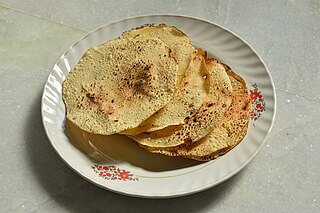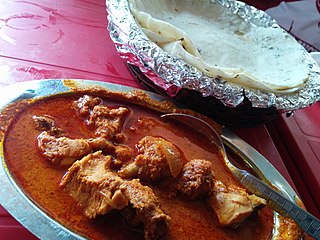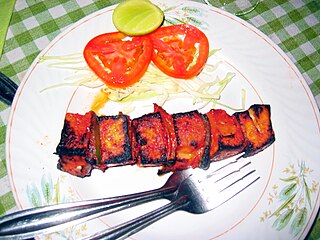Indian cuisine consists of a variety of regional and traditional cuisines native to the Indian subcontinent. Given the diversity in soil, climate, culture, ethnic groups, and occupations, these cuisines vary substantially and use locally available spices, herbs, vegetables, and fruits.

Bhelpuri is a savoury snack originally from India, and is also a type of chaat. It is made of puffed rice, vegetables and a tangy tamarind sauce, and has a crunchy texture.

Pakora is a fritter originating from the Indian subcontinent. They are sold by street vendors and served in restaurants in South Asia. It consists of items, often vegetables such as potatoes and onions, coated in seasoned gram flour batter and deep fried.

Upma, uppumavu, or uppittu is a dish originating from the Indian subcontinent, most common in Kerala, Andhra Pradesh, Tamil Nadu, Telangana, Karnataka, Maharashtrian, and Sri Lankan Tamil breakfast, cooked as a thick porridge from dry-roasted semolina or coarse rice flour. Various seasonings and/or vegetables are often added during the cooking, depending on individual preferences.

A papadam, also known as papad, is an Indian dough of black gram bean flour, either deep fried or cooked with dry heat until crunchy. Other flours made from lentils, chickpeas, rice, tapioca, millet or potato are also used. Papad is typically served as an accompaniment to a meal in India, Pakistan, Bangladesh, Nepal, Sri Lanka and the Caribbean or as an appetizer, often with a dip such as chutneys, or toppings such as chopped onions and chili peppers, or it may be used as an ingredient in curries.

Rajasthani cuisine is the cuisine of the Rajasthan state in North West India. It was influenced by various factors like the warlike lifestyles of its inhabitants, the availability of ingredients in an arid region and by Hindu temple traditions of sampradayas like Pushtimarg and Ramanandi. Food that could last for several days and could be eaten without heating was preferred. Scarcity of water and fresh green vegetables have all had their effect on the cooking. Signature Rajasthani dishes include Dal Baati Churma, Panchratna Dal, Papad ro Saag, Ker Sangri, Gatte ro Saag. It is also known for its snacks like Bikaneri bhujia, Mirchi bada and Kanda kachauri. Other famous dishes include Dal Baati, malaidar special lassi (lassi) and Lashun ki chutney, Mawa lassi from Jodhpur, Alwar ka mawa, Malpauas from Pushkar and rasgulla from Bikaner, "paniya"and "gheriya" from Mewar. Originating for the Marwar region of the state is the concept Marwari Bhojnalaya, or vegetarian restaurants, today found in many parts of India, which offer vegetarian food of the Marwari people. The history also has its effect on the diet as the Rajputs preferred majorly a non-vegetarian diet while the Brahmin, Jains, and others preferred a vegetarian diet. So, the state has a myriad of both types of delicacies.
Malvani cuisine is the standard cuisine of the South Konkan region of the Indian states of Maharashtra and Goa. Although Malvani cuisine is predominantly non-vegetarian, there are many vegetarian dishes. Although it is an independent cuisine, it overlaps Maharashtrian cuisine and Goan cuisine. Malvan is a town in the Sindhudurg district on the west coast of Maharashtra.

Chakli is a savoury snack from India. It is a spiral shaped snack with a spiked surface.
Maharashtrian or Marathicuisine is the cuisine of the Marathi people from the Indian state of Maharashtra. It has distinctive attributes, while sharing much with other Indian cuisines. Traditionally, Maharashtrians have considered their food to be more austere than others.

Indian breads are a wide variety of flatbreads and crêpes which are an integral part of Indian cuisine. Their variation reflects the diversity of Indian culture and food habits.

Chicken curry or curry/curriedchicken is a South Asian dish originating from India. It is common in the Indian subcontinent, Caribbean, Arabian Peninsula, Southeast Asia, Great Britain, and Japan. A typical curry from the Indian subcontinent consists of chicken stewed in an onion- and tomato-based sauce, flavoured with ginger, garlic, tomato puree, chilli peppers and a variety of spices, often including turmeric, cumin, coriander, cinnamon, and cardamom. Outside of South Asia, chicken curry is often made with a pre-made spice mixture known as curry powder.

Hyderabadi cuisine, also known as Deccani cuisine, is the native cooking style of the Hyderabad, Telangana, India. The haute cuisine of Hyderabad began to develop after the foundation of the Bahmani Sultanate, and the Qutb Shahi dynasty centered in the city of Hyderabad promoted the native cuisine along with their own. Hyderabadi cuisine had become a princely legacy of the Nizams of Hyderabad as it began to further develop under their patronage.

Panjiri is a Ayurvedic sweet dish from the Indian subcontinent which is specially prepared for Krishna Janmashtami festival. The sweet panjiri evolved from an Ayurvedic preparation called Panchajīraka.

Maharashtra is the third largest state of India in terms of land area and second largest in terms of population in India. It has a long history of Marathi saints of Varakari religious movement, such as Dnyaneshwar, Namdev, Chokhamela, Eknath and Tukaram which forms the one of bases of the culture of Maharashtra or Marathi culture. Maharashtrian culture had large influence over neighbouring regions under the Maratha Empire.

Baingan bharta or Baigan Chokha is an Indian dish prepared by mincing grilled eggplant (baingan) and mixing it with tomato, onion, herbs and spices. Grilling the eggplant over charcoal or direct fire infuses the dish with a smoky flavour. Mashed eggplant is then mixed with cooked chopped tomato, browned onion, ginger, garlic, cumin, fresh cilantro, chili pepper, and mustard oil or a neutral vegetable oil. Traditionally, the dish is often eaten with flatbread and is also served with rice or raita, a yogurt salad. In Bihar and Uttar Pradesh, it is served hot with litti or baati.

Paneer tikka or Paneer Soola or Chhena Soola is an Indian dish made from chunks of paneer/ chhena marinated in spices and grilled in a tandoor. It is a vegetarian alternative to chicken tikka and other meat dishes. It is a popular dish that is widely available in India and countries with an Indian diaspora.
Thecha is a spicy condiment prepared in the state of Maharashtra in India. It has many variants but the primary ingredients are chili peppers, peanuts and garlic, often tempered in oil and a multitude of spices such as cumin, sesame seeds, coriander seeds, hing, cloves, coriander leaves and grated coconut seasoning. Traditional recipes call for the ingredients to be crushed or pounded in metal or mortar and pestle, but modern kitchens often rely on grinding in food processors. It is served with dishes like pithla bhakri or is eaten with bhakri. A regional variation is the varhadi thecha. It has been described by celebrity chef Sanjeev Kapoor as a popular relish. It spoils after 10 to 15 days.

Daal dhokli is an Indian dish common in Rajasthani and Gujarati cuisine, made by boiling wheat flour pieces in a pigeon pea stew. A similar preparation is called varanfal, or chakolyaa in Marathi.

Vada or Vadai is a category of savoury fried snacks native to India. Vadas can be described variously as fritters, cutlets, or dumplings. Alternative names for this food include vadai, vade, and bada. Vadas are sometimes stuffed with vegetables and traditionally served with chutneys and sambar.

Sai bhaji is a Sindhi vegetarian curry, consisting of dal (lentils), palak (spinach) and other vegetables. It forms a staple part of the local cuisine and is considered a rich source of nutrition due to its mix of various greens.




















